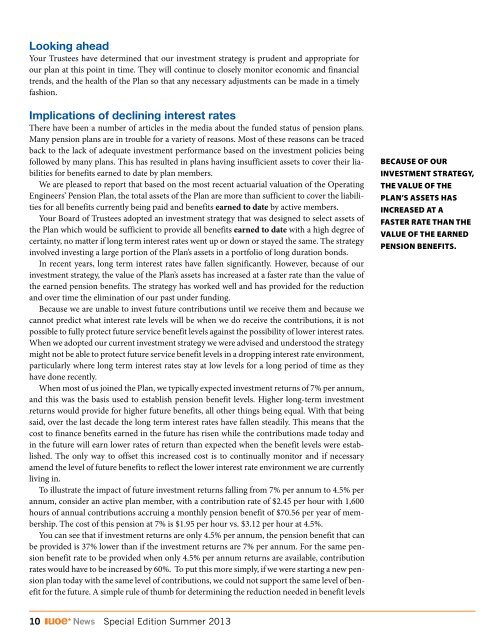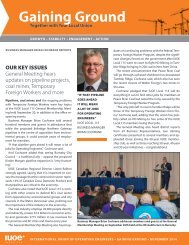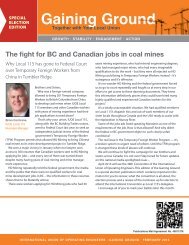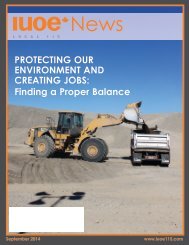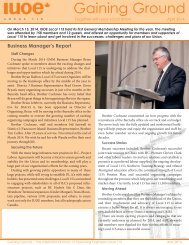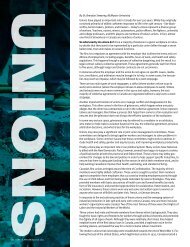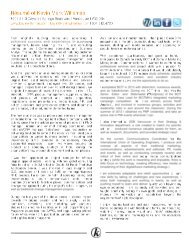OE News Special Edition July 2013
OE News Special Edition July 2013
OE News Special Edition July 2013
You also want an ePaper? Increase the reach of your titles
YUMPU automatically turns print PDFs into web optimized ePapers that Google loves.
Looking ahead<br />
Your Trustees have determined that our investment strategy is prudent and appropriate for<br />
our plan at this point in time. They will continue to closely monitor economic and financial<br />
trends, and the health of the Plan so that any necessary adjustments can be made in a timely<br />
fashion.<br />
Implications of declining interest rates<br />
There have been a number of articles in the media about the funded status of pension plans.<br />
Many pension plans are in trouble for a variety of reasons. Most of these reasons can be traced<br />
back to the lack of adequate investment performance based on the investment policies being<br />
followed by many plans. This has resulted in plans having insufficient assets to cover their liabilities<br />
for benefits earned to date by plan members.<br />
We are pleased to report that based on the most recent actuarial valuation of the Operating<br />
Engineers’ Pension Plan, the total assets of the Plan are more than sufficient to cover the liabilities<br />
for all benefits currently being paid and benefits earned to date by active members.<br />
Your Board of Trustees adopted an investment strategy that was designed to select assets of<br />
the Plan which would be sufficient to provide all benefits earned to date with a high degree of<br />
certainty, no matter if long term interest rates went up or down or stayed the same. The strategy<br />
involved investing a large portion of the Plan’s assets in a portfolio of long duration bonds.<br />
In recent years, long term interest rates have fallen significantly. However, because of our<br />
investment strategy, the value of the Plan’s assets has increased at a faster rate than the value of<br />
the earned pension benefits. The strategy has worked well and has provided for the reduction<br />
and over time the elimination of our past under funding.<br />
Because we are unable to invest future contributions until we receive them and because we<br />
cannot predict what interest rate levels will be when we do receive the contributions, it is not<br />
possible to fully protect future service benefit levels against the possibility of lower interest rates.<br />
When we adopted our current investment strategy we were advised and understood the strategy<br />
might not be able to protect future service benefit levels in a dropping interest rate environment,<br />
particularly where long term interest rates stay at low levels for a long period of time as they<br />
have done recently.<br />
When most of us joined the Plan, we typically expected investment returns of 7% per annum,<br />
and this was the basis used to establish pension benefit levels. Higher long-term investment<br />
returns would provide for higher future benefits, all other things being equal. With that being<br />
said, over the last decade the long term interest rates have fallen steadily. This means that the<br />
cost to finance benefits earned in the future has risen while the contributions made today and<br />
in the future will earn lower rates of return than expected when the benefit levels were established.<br />
The only way to offset this increased cost is to continually monitor and if necessary<br />
amend the level of future benefits to reflect the lower interest rate environment we are currently<br />
living in.<br />
To illustrate the impact of future investment returns falling from 7% per annum to 4.5% per<br />
annum, consider an active plan member, with a contribution rate of $2.45 per hour with 1,600<br />
hours of annual contributions accruing a monthly pension benefit of $70.56 per year of membership.<br />
The cost of this pension at 7% is $1.95 per hour vs. $3.12 per hour at 4.5%.<br />
You can see that if investment returns are only 4.5% per annum, the pension benefit that can<br />
be provided is 37% lower than if the investment returns are 7% per annum. For the same pension<br />
benefit rate to be provided when only 4.5% per annum returns are available, contribution<br />
rates would have to be increased by 60%. To put this more simply, if we were starting a new pension<br />
plan today with the same level of contributions, we could not support the same level of benefit<br />
for the future. A simple rule of thumb for determining the reduction needed in benefit levels<br />
10 <strong>News</strong> <strong>Special</strong> <strong>Edition</strong> Summer <strong>2013</strong><br />
BECausE oF ouR<br />
invEstMEnt stRatEgy,<br />
thE vaLuE oF thE<br />
pLan’s assEts has<br />
inCREasED at a<br />
FastER RatE than thE<br />
vaLuE oF thE EaRnED<br />
pEnsion BEnEFits.


